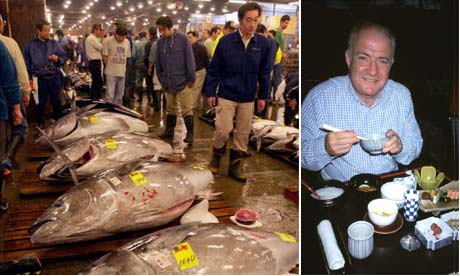
It all started when I met the Japanese ambassador at a banquet for the Lord Mayor of London. He's a true gourmet and a big fan of traditional British food, but after watching my efforts on Food Heroes he told me in no uncertain terms that while I may know how to cook a Dover sole, I knew nothing about sushi. I said, "I'll go to Japan, learn how to make the food and come back and create a Japanese banquet for you."
The first day in Tokyo was disorientating - all neon, gadgets and extreme politeness - but I was surprised to find that I have a lot in common with the Japanese because they're bonkers about food. The Tsukiji market in Tokyo sells £20m of fish each day, a lot of it live, kept in large buckets and sold at a premium because of the Japanese obsession with freshness. Octopus, sea squirts, live tiger prawns, blood clams, babylons and the prickly Arctic snow crab thrash about in this Disney-like aquarium. But tuna is the real deal, both frozen and fresh. It's their roast beef - one fish can cost £5,000, and around New Year the price reaches up to £50,000.
All around the market, superb hole-in-the-wall restaurants specialise in sashimi, tempura, noodles or sushi. It would be difficult to find anything as fresh this cheaply anywhere else. I had squid, bream and tuna all fresh from the market served with wasabi and vinegar rice. One of the chefs told me he'd become a sushi master after four days' training. Unfortunately, he was joking. It can take 10 years - it's not just knowing how to choose fish and slice it, you also have to learn to prepare it in front of people. They work so cleanly and precisely, and that theatricality is part of what you pay for.
From Tokyo, we went northwest to Kanazawa on the Sea of Japan. In the charming old town centre, I found a great noodle bar with seating for just 10 people and a husband and preparing superb noodles. Later, in complete contrast, I had a grand meal at Asadaya restaurant which boasts 16 generations of cooking. Despite the formality, I have never had such a wonderful meal. Domes of ice covered the prettiest display of sashimi I've ever seen. A boat made from konbu kelp was filled with abalone, red snapper and leeks.
Cooking in Japan is regarded as an art, like music or painting. Every dish has a reason, including the garnishes. This is cuisine with philosophy, and the apparent simplicity belies centuries of culture. I couldn't help but be in awe.
Back in London, I had to prepare an eight-course banquet at the Japanese embassy - while trespassing on the kitchen of the two embassy chefs whose skills were far beyond mine. In my own restaurant. I serve seafood simply, but you can't do that for a banquet, so I asked the two chefs for a few tips. For the starter of marinaded sardines - the only Western thing on the menu - they took the skin off the sardines and cut delicate diamond designs in them. For the sashimi course, I used brill and red mullet, because they were at their autumnal prime. I brought all the fish from Cornwall, even live spider crabs because I know the Japanese could taste that extra bit of freshness.
But I bottled out of doing sushi. I realise now that I have another 10 years to go before I try that again. But the whole experience has transformed my way of thinking of seafood. It's been a voyage of discovery and when I had finished the meal and visited the dining room, it was a relief to hear the applause. In that lovely restrained Japanese way, the ambassador stood up and simply said, "You've done it."
Rick Stein and the Japanese Ambassador is on BBC2 on Tuesday at 8pm, repeated on Thursday at 7pm.
· STA (statravel.co.uk, 0870 1607535) is offering a seven-day Japanese culinary holiday from £590pp, including transport, accommodation in a traditional inn, cooking course, some meals and a visit to the Tokyo fish market, but not flights. Japan Travel Centre (0870 8900360, japantravel.co.uk) has six days in Tokyo including four nights accommodation and London flights from £679.

